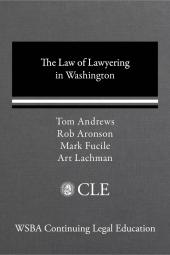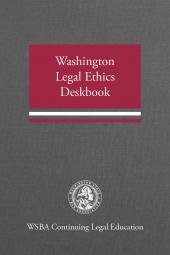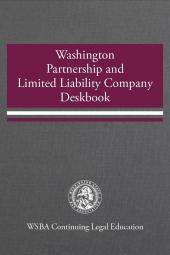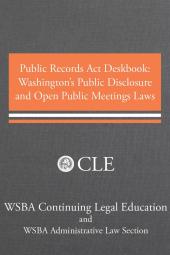The Law of Lawyering in Washington
This one-volume treatise provides broader and deeper treatment of the law of lawyering in the state of Washington than is currently available in any other work. The multiple sources of the law of lawyering are compiled, placed into historical and national context, analyzed - and where the authors deem it necessary - criticized.
Select a format
 International Order Inquiry
International Order Inquiry
Select subscription type
Terms & conditions
Subscribers receive the product(s) listed on the Order Form and any Updates made available during the annual subscription period. Shipping and handling fees are not included in the annual price.
Subscribers are advised of the number of Updates that were made to the particular publication the prior year. The number of Updates may vary due to developments in the law and other publishing issues, but subscribers may use this as a rough estimate of future shipments. Subscribers may call Customer Support at 800-833-9844 for additional information.
Subscribers may cancel this subscription by: calling Customer Support at 800-833-9844; emailing customer.support@lexisnexis.com; or returning the invoice marked "CANCEL".
If subscribers cancel within 30 days after the product is ordered or received and return the product at their expense, then they will receive a full credit of the price for the annual subscription.
If subscribers cancel between 31 and 60 days after the invoice date and return the product at their expense, then they will receive a 5/6th credit of the price for the annual subscription. No credit will be given for cancellations more than 60 days after the invoice date. To receive any credit, subscriber must return all product(s) shipped during the year at their expense within the applicable cancellation period listed above.
The total price includes the product(s) listed in the Order Form and any Updates for a limited period (minimum period of 30 days) after the order is placed ("Order Window"). Shipping and handling fees are not included in the grand total price.
All shipments may be returned, at subscribers' expense, for full credit of the Price within 30 days of receipt.
Shipments may not be returned, and no credits will be issued, more than 30 days after receipt.
After the Order Window, subscribers will receive notice of Updates along with the then-current grand total price and order process as Updates become available. Subscribers will only be shipped those Updates they specifically request.
Product description
View a sample of this title using the ReadNow feature
Much of what lawyers do in practice requires the exercise of professional judgment in the face of uncertainty: governing principles can be murky, and factual contexts vary widely. This book is designed to assist lawyers in assessing risks and making informed judgments about their professional obligations using all the relevant aspects of the law of lawyering.
First, we have tried to take full account of the multiple sources of the law of lawyering (Rules of Professional Conduct, common law, legislative enactments, and constitutional provisions). Second, we have placed the existing rules constraining lawyers’ conduct into both historical and national context. Third, we have tried to avoid the impression that everything a lawyer needs to know about the "law of lawyering" can be found in the existing rules and their interpretations.
As we hope will be seen throughout, we believe that sound social policy, and ultimately the demands of institutional, distributive, and interpersonal "justice," should guide our conduct as professionals. We believe that Washington lawyers will be well served by a book that starts by setting out what that law is as clearly and succinctly as possible and only then seeks to evaluate and (where necessary) criticize that law. Thus, in each section we have, insofar as possible, set out the existing law before giving our views about that law. In each section that contains our critical evaluation of the existing law, that evaluation is introduced with the heading "Author's Commentary" and placed in a box to set it off from the rest of the discussion.
At the beginning of each chapter, we have listed the primary rules and statutes before proceeding to our analysis. We have started with Washington law when that is clear. Insofar as we have needed to venture outside of Washington, we have looked to the ABA model rules and standards for comparison and guidance and, where it seems relevant and helpful, to the rules or law of other states. In trying to situate Washington law in the context of national law, we have drawn heavily on the Restatement of the Law Governing Lawyers, an immensely valuable resource for all lawyers interested in the legal rules that govern their behavior.
To learn more about WSBA products, please visit store.lexisnexis.com/site/wsba
eBooks, CDs, downloadable content, and software purchases are noncancelable, nonrefundable and nonreturnable. Click here for more information about LexisNexis eBooks. The eBook versions of this title may feature links to Lexis+® or Lexis® service for further legal research options. A valid subscription to Lexis+ or Lexis is required to access this content.
Table of contents
Introduction
About the Authors
Chapter 1 Authority to Regulate the Practice of Law (Tom Andrews)
Chapter 2 Admission to Practice and Unauthorized Practice (Tom Andrews, Mark Fucile)
Chapter 3 An Introduction to the Rules of Professional Conduct: Their Purpose and
Limits (Tom Andrews)
Chapter 4 Defining the Attorney-Client Relationship (Tom Andrews)
Chapter 5 Competence, Diligence, and Communication: The Essential Three (Tom
Andrews, Rob Aronson)
Chapter 6 Confidentiality (Tom Andrews, Rob Aronson)
Chapter 7 Conflicts of Interest (Rob Aronson)
Chapter 8 The Rules of Advocacy (Tom Andrews)
Chapter 9 Fees and Trust Accounts (Art Lachman)
Chapter 10 Candor (Tom Andrews)
Chapter 11 Law-Firm Marketing (Mark Fucile)
Chapter 12 Maintaining the Integrity of the Profession (Tom Andrews)
Chapter 13 Lawyer's Responsibilities for Assisting in Access to Justice (Tom Andrews)
Chapter 14 Law-Practice Organization, Management, and Sales (Mark Fucile)
Chapter 15 Legal Malpractice and Other Theories of Lawyer Liability (Mark Fucile)
Chapter 16 Disciplinary System (Tom Andrews)
Table of Cases
Table of Statutes and Rules
References
Subject Index
 Lexis Nexis
Lexis Nexis 


